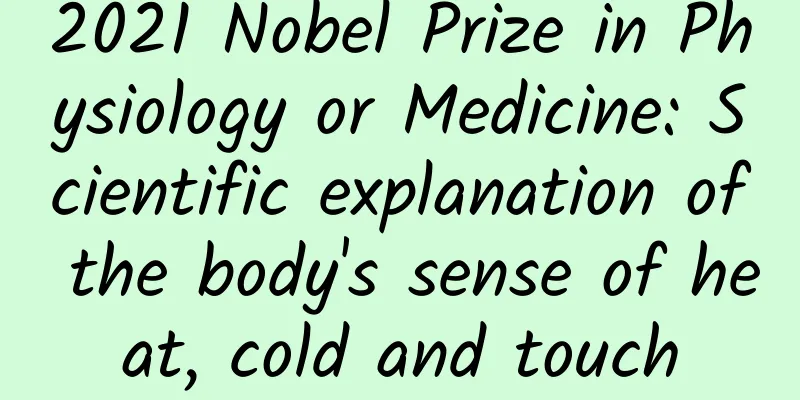2021 Nobel Prize in Physiology or Medicine: Scientific explanation of the body's sense of heat, cold and touch

|
Written by | Fanpu At 11:30 a.m. local time on October 4, 2021 in Sweden (17:30 p.m. Beijing time on October 4), the Nobel Prize Committee announced that the 2021 Prize in Physiology or Medicine will be awarded to American physiologist David Julies and Armenian-American neuroscientist Ardem Patapoutian in recognition of their discovery of receptors for temperature and touch. In our daily lives, we take the sensations of heat, cold and touch for granted. But these phenomena, which are essential for human survival, have no scientific explanation. How does the nervous system perceive and interpret our environment? How are temperature and mechanical stimuli converted into electrical impulses in the nervous system? How are nerve impulses initiated to sense temperature and pressure? This year's Nobel Prize winners David Julies and Ardem Patapoutian provide answers to these fundamental questions. David Julies used capsaicin to identify sensors in the skin’s nerve endings that respond to heat. Ardem Patapoutian used pressure-sensitive cells to discover a new class of receptors that respond to mechanical stimuli in the skin and internal organs. These groundbreaking discoveries have opened up a wealth of new research and are rapidly advancing our understanding of how our nervous systems sense heat, cold, and mechanical stimuli. The two laureates have identified critical missing links in understanding the complex interplay between our senses and our environment. Identification of temperature receptors by capsaicin In the late 1990s, it was known that capsaicin can activate nerve cells and trigger the feeling of pain, but how exactly does this chemical work? David Julies saw hope in solving a key mystery. He led a team to create a database of millions of DNA fragments corresponding to genes expressed in sensory neurons that can respond to pain, heat, and touch. They believed that the library would contain a DNA fragment that could encode a protein that responds to capsaicin. They expressed individual genes from the library in cultured cells that normally did not respond to capsaicin. After a painstaking search, a single gene was identified that made cells sensitive to capsaicin—the capsaicin-sensing gene had been found! Further experiments showed that this gene encoded a new ion channel protein. The newly discovered capsaicin receptor was later named TRPV1. Julies realized that he had discovered a heat-sensing receptor that would be activated when the temperature rose to a painful level. We now understand how different temperatures induce electrical signals in the nervous system. The discovery of TRPV1 was a major breakthrough that led the way to the discovery of other temperature-sensitive receptors. David Julius and Ardem Patapoutian independently used menthol to identify TRPM8, a receptor activated by cold. Ion channels related to TRPV1 and TRPM8 were also discovered and found to be activated by a range of different temperatures. Real pressure As for how we feel "pressure", the researchers did not come up with a neural mechanism in vertebrates, but only found mechanical receptors in bacteria. Ardem Patapoutian of the Scripps Research Institute was involved in the study. He and his collaborators first identified a cell line that sends electrical signals when the cells are pricked by microneedles. Because they speculated that the receptor stimulated by mechanical external force is an ion channel, they screened 72 candidate genes encoding receptors. Similarly, after a lot of work, Ardem Patapoutian finally identified a single gene - when the gene is silenced, it makes the cell insensitive to the prick of the microneedle. By culturing cells that are sensitive to mechanical pressure, a new ion channel that can be activated by mechanical force was discovered, named Piezo1. "Piezo" means "pressure" in Greek. Then they found another gene that can be expressed at high levels by sensory neurons, namely Piezo2. They determined that this is also an ion channel that can be activated by pressure on the surface of the cell membrane. Subsequent studies have found that Piezo2 is also critical for the perception of body posture and movement. Piezo1 and Piezo2 have also been shown to play a major role in physiological processes, including blood pressure, breathing and bladder control. In the official Nobel Prize press release, they used "It all makes sense!" to describe the work of David Julies and Ardem Patapoutian. Their groundbreaking discoveries of TRPV1, TRPM8 and Piezo channels have enabled us to understand how heat, cold and mechanical forces initiate nerve impulses, allowing us to perceive and adapt to the world around us. A large amount of research initiated by the discoveries of these two scientists has focused on elucidating the functions of these ion channels in various physiological processes, helping us develop treatments for various diseases such as chronic pain. David Julius is an American physiologist and professor at the University of California, San Francisco. Julius was born in 1955. He graduated from MIT in 1977, received his Ph.D. from the University of California, Berkeley in 1984, and completed a postdoctoral program at Columbia University in 1989. Julius was awarded the inaugural Perl-UNC Neuroscience Prize (2000) and the Shaw Prize in 2010. He is also the recipient of the 2020 Breakthrough Prize in Life Sciences and the 2020 Kavli Prize in Neuroscience (with Ardem Patapoutian). Ardem Patapoutian is an Armenian-American molecular biologist and neuroscientist. Patapoutian was born in Beirut, Lebanon in 1967. He moved to the United States in 1986 and received a bachelor's degree in cell and developmental biology from UCLA in 1990 and a doctorate in biology from California Institute of Technology in 1996. During his postdoctoral research, he worked with Louis F. Reichardt at the University of California, San Francisco. In 2000, Patapoutian became an assistant professor at the Scripps Research Institute and has been a researcher at the Howard Hughes Medical Institute (HHMI) since 2014. In 2016, Patapoutian was elected a Fellow of the American Association for the Advancement of Science, in 2017 a Fellow of the National Academy of Sciences, and in 2020 a Fellow of the American Academy of Arts and Sciences. In addition, Patapoutian has also won the 2017 W. Alden Spencer Award, the 2019 Rosenstiel Award, the 2020 Kavli Neuroscience Prize and the BBVA Foundation Frontiers of Knowledge in Biology/Biomedicine Award. |
<<: Will artificial starch advance the progress of human civilization?
Recommend
Live broadcast room operation, process and framework!
In 2020, the popularity of Douyin live streaming ...
A woman got nasopharyngeal cancer just because she ate this dish frequently! Many people eat this dish every day...
Expert of this article: Hu Zhongdong, Chief Physi...
Did you know that tea, coffee, oil and water can also make people "drunk"?
Did you know that in addition to alcohol, drinkin...
Apple Pay reveals new issue: Cannot add bank cards after system restore
On January 2, although restoring the factory sett...
Product analysis of Kuaishou, Douyin and Weishi!
The article conducts a comparative analysis of th...
Product operation, how to build an operation system?
[Introduction] DAU, GMV, CPM, CPC... This series ...
How to avoid invalid traffic in advertising?
Recently, developers have frequently been banned ...
Li Songwei's systematic family parenting training camp to cultivate self-responsible children course audio + transcript
Li Songwei's systematic family parenting trai...
Content Operation丨How to maximize the value of Internet celebrities?
As an investor, I am unlikely to choose to invest...
After three rehearsals, the first flight of the new generation of moon landing rocket has no date
Do you remember NASA's new generation manned ...
SEO diagnostic analysis: How does a website that earns over 1 million yuan a year do SEO optimization?
Nowadays, it is rare to see websites that make mi...
Women's pension insurance: SEO is better to modify the simple web page template
We know that after the front-end page development...
In addition to selling traffic, there are many other ways to monetize new media.
Last Friday, the fashion giant "Rebecca'...
Huawei App Market brand resource bidding promotion process!
1. Introduction to brand resource bidding promoti...
MIUI8 uses a new font, Xiaomi Lanting, which Meizu once abandoned?
Yesterday was the big day of the release of MIUI 8...









